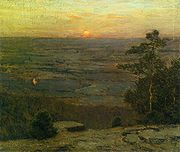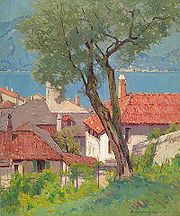
Charles Warren Eaton
Encyclopedia

Tonalism
Tonalism was an artistic style that emerged in the 1880s when American artists began to paint landscape forms with an overall tone of colored atmosphere or mist. Between 1880 and 1915, dark, neutral hues such as gray, brown or blue, often dominated compositions by artists associated with the style...
landscapes. He earned the nickname "the pine tree painter" for his numerous depictions of Eastern White Pine
Eastern White Pine
Pinus strobus, commonly known as the eastern white pine, is a large pine native to eastern North America, occurring from Newfoundland west to Minnesota and southeastern Manitoba, and south along the Appalachian Mountains to the northern edge of Georgia.It is occasionally known as simply white pine,...
trees.
Eaton was born in Albany, New York
Albany, New York
Albany is the capital city of the U.S. state of New York, the seat of Albany County, and the central city of New York's Capital District. Roughly north of New York City, Albany sits on the west bank of the Hudson River, about south of its confluence with the Mohawk River...
to a family of limited means. He starting working at age nine, and worked at a dry goods store in Albany into his early adulthood. When Eaton was twenty-two, a friend's amateur painting sparked his interest in art. He moved to New York City in 1879 to work during the day and attend classes at the National Academy of Design
National Academy of Design
The National Academy Museum and School of Fine Arts, founded in New York City as the National Academy of Design – known simply as the "National Academy" – is an honorary association of American artists founded in 1825 by Samuel F. B. Morse, Asher B. Durand, Thomas Cole, Martin E...
and the Art Students League
Art Students League of New York
The Art Students League of New York is an art school located on West 57th Street in New York City. The League has historically been known for its broad appeal to both amateurs and professional artists, and has maintained for over 130 years a tradition of offering reasonably priced classes on a...
at night. He also used his time off to practice sketching.
Eaton's entrance into the art world coincided with a profound change in the prevailing artistic style in America. In the late 1870s the highly realistic and detailed Hudson River School
Hudson River school
The Hudson River School was a mid-19th century American art movement embodied by a group of landscape painters whose aesthetic vision was influenced by romanticism...
manner, which had dominated the American art scene for over forty years, was giving way to a much looser, moodier style that younger artists were bringing home from Europe. This new style, which would later come to be known as tonalism, emphasized low-key colors and tended to depict intimate settings rather than scenes of grandeur. Eaton adopted this new style in New York and became friends with two other tonalist artists, Leonard Ochtman
Leonard Ochtman
Leonard Ochtman was an American Impressionist painter who specialized in landscapes. He was born in Zonnemaire, Netherlands as the son of a decorative painter. His family moved to Albany, New York in 1866. Starting at a young age, Ochtman worked as a draftsman at a wood-working firm in Albany...
and Ben Foster.

The New York Times
The New York Times is an American daily newspaper founded and continuously published in New York City since 1851. The New York Times has won 106 Pulitzer Prizes, the most of any news organization...
. He also exhibited with the newly formed Society of American Artists
Society of American Artists
The Society of American Artists was an American artists group. It was formed in 1877 by artists who felt the National Academy of Design did not adequately meet their needs, and was too conservative....
in 1884 with an uncharacteristic still-life (Eaton painted landscapes nearly exclusively). By 1886 he quit his day job and devoted all of his time to art.
Eaton held the work of Robert Swain Gifford
Robert Swain Gifford
Robert Swain Gifford was an American landscape painter. He was influenced by the Barbizon school.Much of his work focuses on the landscapes of New England, where he was born. He, along with Victorian contemporaries from the White Mountain and Hudson River Schools, helped immortalize the majestic...
in particularly high regard, as well as that of George Inness
George Inness
George Inness was an American landscape painter; born in Newburgh, New York; died at Bridge of Allan in Scotland. His work was influenced, in turn, by that of the old masters, the Hudson River school, the Barbizon school, and, finally, by the theology of Emanuel Swedenborg, whose spiritualism...
. Eaton and Inness worked in the same building in New York in 1889, and Inness stopped to admire Eaton's landscapes outside his studio. He called on Eaton the next day and purchased a painting, and the two became friends. Eaton however, who had already established himself as a successful artist, was more of an admirer of Inness than a follower.
Eaton reached his maturity as an artist in the 1890s and 1900s with two distinctive landscape subjects. The first subject, tonalist in style, was a landscape typically containing pasture, trees and sometimes a small patch of water or stone fence. The overall mood in these paintings is one of intimacy. The second subject, more stately in manner, was a landscape with a grouping of tall pine trees, often backlit with the glow of a setting sun. He developed this second subject into some of his largest works, and was so successful with them he became known as "the pine tree painter". Eaton almost never included human or animal figures in his landscapes.
Eaton worked primarily in oil and watercolor. He was a founding member of the American Watercolor Society
American Watercolor Society
The American Watercolor Society is a nonprofit membership organization devoted to the advancement of watercolor painting in the United States. It was founded in 1866 by eleven painters and, originally, was known as the American Society of Painters in Water Colors...
. He exhibited at the well-known Macbeth Gallery in New York for over thirty years, in Paris via the famous dealer Paul Durand-Ruel
Paul Durand-Ruel
Paul Durand-Ruel was a French art dealer who is associated with the Impressionists. He was one of the first modern art dealers who provided support to his painters with stipends and solo exhibitions....
, and at important international expositions. He also served on numerous exhibition juries. For reasons that are unclear but possibly political in nature, Eaton never gained full membership to the National Academy nor to the Society for American Artists.
Despite his success with tonalism, Eaton gradually discarded the shadowy tonalist style and began painting with brighter colors, especially after 1910. Never a true impressionist
Impressionism
Impressionism was a 19th-century art movement that originated with a group of Paris-based artists whose independent exhibitions brought them to prominence during the 1870s and 1880s...
, Eaton painted in a loosely realist style. Many works from his later career depicted European scenes, where Eaton traveled regularly as an adult. He particularly favored the countryside around Bruges
Bruges
Bruges is the capital and largest city of the province of West Flanders in the Flemish Region of Belgium. It is located in the northwest of the country....
as well as Lake Como
Lake Como
Lake Como is a lake of glacial origin in Lombardy, Italy. It has an area of 146 km², making it the third largest lake in Italy, after Lake Garda and Lake Maggiore...
in Italy, which he painted with a particularly bright palette.
By the 1920s Eaton's output and creativity had faded. The Great Depression
Great Depression
The Great Depression was a severe worldwide economic depression in the decade preceding World War II. The timing of the Great Depression varied across nations, but in most countries it started in about 1929 and lasted until the late 1930s or early 1940s...
demolished the art market, and Eaton's sales dried up. He moved to Bloomfield, New Jersey
Bloomfield, New Jersey
Bloomfield is a township in Essex County, New Jersey, United States. As of the 2010 United States Census, the township population was 47,315. It surrounds the Bloomfield Green Historic District.-History:...
in the 1880s, and lived a quiet retirement with his sister and niece before his death in 1937. He was buried at Bloomfield Cemetery
Bloomfield Cemetery, Bloomfield
Bloomfield Cemetery is located at 383 Belleville Avenue, Bloomfield in Essex County, New Jersey. The telephone number is 748-0131.-Notable burials:...
.
His works, like many artists of his generation, were nearly forgotten for decades until a resurgence of interest in the late twentieth century.

